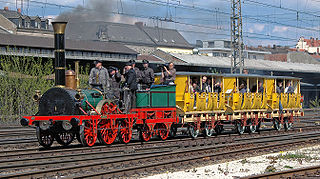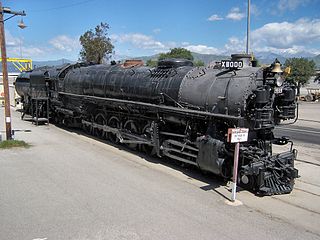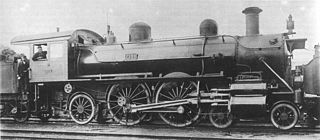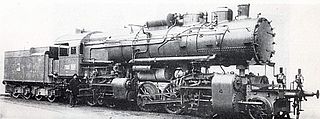
Orenstein & Koppel was a major German engineering company specialising in railway vehicles, escalators, and heavy equipment. It was founded on April 1, 1876, in Berlin by Benno Orenstein and Arthur Koppel.

The locomotive Saxonia was operated by the Leipzig–Dresden Railway Company and was the first practical working steam locomotive built in Germany. Its name means Saxony in Latin.

Under the Whyte notation for the classification of steam locomotives, 4-2-2 represents the wheel arrangement of four leading wheels on two axles, two powered driving wheels on one axle, and two trailing wheels on one axle.

Under the Whyte notation for the classification of steam locomotives, 2-2-2 represents the wheel arrangement of two leading wheels on one axle, two powered driving wheels on one axle, and two trailing wheels on one axle. The wheel arrangement both provided more stability and enabled a larger firebox than the earlier 0-2-2 and 2-2-0 types. This wheel arrangement is sometimes described as a Single, although this name could be used to describe any kind of locomotive with a single pair of driving wheels.

The GWR 4100 Class was a class of steam locomotives in the Great Western Railway (GWR) of the United Kingdom.

The Union Pacific Railroad 9000 Class was a class of 88 steam locomotives, built by ALCO for the Union Pacific between 1926 and 1930.

The Deutsche Reichsbahn-Gesellschaft's BR 01 steam locomotives were the first standardised (Einheitsdampflokomotive) steam express passenger locomotives built by the unified German railway system. They were of 4-6-2 "Pacific" wheel arrangement in the Whyte notation, or 2′C1′ h2 in the UIC classification. The idea of standardisation was that it would reduce maintenance costs; i.e. if a BR 01 whose engine shop was in, say, Berlin broke down in Dresden, instead of having to ship the necessary part from Berlin and take the locomotive out of service, a part from the Dresden shop could be used as all of the engines, parts, and workings were exactly the same and produced nationwide. Thus it was a "standard" product for engine shops.

The Prussian state railways' Class P 10 were 2-8-2 "Mikado" type passenger-hauling steam locomotives built for hauling heavy express trains in the hilly terrain of the Mittelgebirge. They were the last Prussian passenger train steam locomotives to be developed in Prussia before the state railways were merged into the Deutsche Reichsbahn, who eventually designated them as DRG Class 39.
A compound locomotive is a steam locomotive which is powered by a compound engine, a type of steam engine where steam is expanded in two or more stages. The locomotive was only one application of compounding. Two and three stages were used in ships, for example.

The Adler was the first locomotive that was successfully used commercially for the rail transport of passengers and goods in Germany. The railway vehicle was designed and built in 1835 by the British railway pioneers George and Robert Stephenson in the English city of Newcastle. It was delivered to the Bavarian Ludwig Railway for service between Nuremberg and Fürth. It ran officially for the first time there on 7 December 1835. The Adler was a steam locomotive of the Patentee type with a wheel arrangement of 2-2-2 or 1A1. The Adler was equipped with a tender of type 2 T 2. It had a sister locomotive, the Pfeil.

The Class S 2/5 locomotives operated by the Royal Bavarian State Railways included two express train, steam locomotives of American origin which were fitted with Vauclain compound engines.

The German Class 41 steam locomotives were standard goods train engines (Einheitslokomotiven) operated by the Deutsche Reichsbahn (DRB) and built from 1937 to 1941.

The Einheitsdampflokomotiven, sometimes shortened to Einheitslokomotiven or Einheitsloks, were the standardized steam locomotives built in Germany after 1925 under the direction of the Deutsche Reichsbahn-Gesellschaft. Their manufacture made extensive use of standard design features and components.
The Saxon Class XV HTV was a class of goods train steam locomotive operated by the Royal Saxon State Railways, which had been conceived for hauling trains and acting as banking engines for routes in the Ore Mountains. In 1925 the Deutsche Reichsbahn grouped them into their DRG Class 79.0.
The locomotives WURZEN and OSCHATZ were early German steam engines operated by the Leipzig–Dresden Railway Company (LDE) for mixed duties. They were tender locomotives.
The ELBE to HAYN series of early, German, steam locomotives were equipped with tenders and operated by the Leipzig–Dresden Railway Company.

A steam motor is a form of steam engine used for light locomotives and light self-propelled motor cars used on railways. The origins of steam motor cars for railways go back to at least the 1850s, if not earlier, as experimental economizations for railways or railroads with marginal budgets. These first examples, at least in North America, appear to have been fitted with light reciprocating engines, and either direct or geared drives, or geared-endless chain drives. Most incorporated a passenger carrying coach attached to the engine and its boiler. Boiler types varied in these earlier examples, with vertical boilers dominant in the first decade and then with very small diameter horizontal boilers. Other examples of steam motor cars incorporated an express-baggage or luggage type car body, with coupling apparatus provided to allow the steam motor car to draw a light passenger coach.

The Grand Duchy of Mecklenburg Friedrich-Franz Railway grouped various 2-4-0 steam locomotives built between 1849 and 1856 into its Class II. These included five locomotives that had originally been delivered with a 2-2-2 wheel arrangement.

The MÁV class 601 was a class of Hungarian four-cylinder Mallet locomotives, which was designed to haul long and very heavy cargo on very steep railway tracks. At 22.5 m long and outputting 2,200 kW (3,000 hp), they were the largest and most powerful steam locomotives built in Europe before and during World War I.

The class IV h (four-h) locomotives of the Grand Duchy of Baden State Railway (German: Großherzoglich Badische Staatseisenbahnen, G.Bad.St.E.) were express locomotives with a 4-6-2 (Pacific) wheel arrangement. They later passed to the Deutsche Reichsbahn, who classified them as class 183.
















